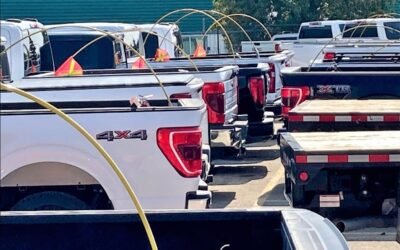How Government Fleets are Changing Acquisition Strategy During COVID-19
The COVID-19 pandemic has certainly established a new normal across the world, a state in which it’s quite hard to predict what will happen in the coming few months. However, true to the saying, “the show must go on”, the fleet industry has proven to be quite resilient in the face of the ongoing pandemic.
Due to the essential nature of government and state fleets, they certainly didn’t have the option of withholding operations and they have continued to rise to the ongoing challenge. With that said, many fleets are concerned that their budgets might be slashed by at least 10% in the next few months.
This is perhaps why government fleet acquisition has seen a steady decline. Many fleets are opting to cut their costs by acquiring fewer vehicles. However, this might be a short-sighted decision as it can increase operational expenditure over time. This is because the limited assets will age and need more unscheduled maintenance, which will lead to increased expenditure. The short-term benefit of capital expenditure simply does not outweigh the long-term loss.
The Critical Role of the Fleet Manager in Government Fleet Acquisition
This is where the role of a fleet manager comes into play. The decision-makers might be tempted to address the immediate issues created by decreased tax revenues. However, it’s the fleet manager’s job to rectify false impressions and use solid data to showcase how detrimental it will be to curb government fleet acquisition. After all, a fleet company’s lifecycle management policy should not be sidelined to reduce immediate costs. You simply cannot postpone asset replacement and run the existing ones into the ground.
Some directives that a fleet manager can expect to get from the higher-ups include right-sizing the fleet, curtailing the facility to take the vehicles home, and reducing operating and capital costs. Even though all of these directives are worth discussing, let’s focus on the immediate one about reducing capital costs.
Many fleets buy their vehicles upfront, which is referred to as “pay-before-you-go” financing. This only ties up your money for the long-haul and prevents you from using it to fund vehicle replacements for the next few years. However, fleet managers can’t depend on precedent anymore, particularly if they want to maintain their operational capability. The budget cuts will impact the operation of assets, increase the downtime, and make internal fleet customers and taxpayers unhappy.
So, what can a fleet manager do?
Thoroughly Scrutinize the Acquisition Strategy
The first step is to examine the government fleet acquisition strategy from cover to cover. You need to review whether the fleet is of the right size or not and whether you need to increase the fleet size to have an appropriate number of sanitized vehicles on deck.
Next, you need to see if you have the appropriate vehicles for all jobs and if you will engage internal customers to select your vehicles. You also need to look at the Total Cost of Ownership (TCO) and determine the ideal replacement cycle timing for each vehicle.
You should also explore other vehicles that meet your requirements and offer better incentives and residual value. You must find chances to short-cycle assets to benefit from strong residual values. Time your vehicle orders based on order-to-delivery and up-fitting timelines. You must also ask yourself if extending a vehicle is the right choice for your fleet.
After finalizing your fleet acquisition strategy, you need to pull together your financing options. It will help you create a custom program that addresses all of your needs.
Choose Your Fleet Financing Options
Here are some “pay-as-you-go” financing methods that will enable you to replace your assets and also help free up your cash. You can use any combination of these methods to meet your government fleet acquisition goals:
Renting
Renting has the lowest risk of any financing option. Generally, you can rent vehicles for as short as one day, but with most organizations it makes more financial sense to rent for at least a month. Most long-term rental companies like Summit Fleet, require a minimum rental period of a month. The renter is responsible for excess wear and tear and excess mileage, and there are some restrictions on vehicle modification.
Open-End (TRAC) Lease
The renter is responsible for residual risk and the shortfall if the rented vehicle doesn’t sell for its value at the end of the term. Conversely, the renter will benefit from the gain if it sells for more than book value. You have to meet a 12-month minimum for a flexible term. It does not include any excess wear and tear penalties. You don’t have any restrictions on vehicle modification.
Closed-End (Walkaway) Lease
You can customize this lease for specific usage requirements and mileage. It doesn’t have any residual risk, but you don’t gain anything on sale either. You can simply walk away at the end of the term with zero obligations. However, if you want to terminate the lease earlier than the term, then you will have to pay the designated penalty. It also comes with excess wear and tear and mileage penalties.
Finance (Capital) Lease
Even though it has higher monthly payments, the renter has full use of the vehicle over its economic life and beyond. Typically, the title gets automatically conveyed at lease end with a minimal payment consideration of $1. The full cost is repaid after the lease term. This is arguably the best least for assets with a long lifecycle and steady tech. The only downside is that if you exercise your purchase options before the lease end, then they can be costly for you.
Municipal Lease (Tax-Exempt Lease Purchase)
This lease is only for non-profit organizations with a government-sponsored unit and political subdivisions. It has the lowest interest rates and it isn’t considered as debt. If you exercise the non-appropriations clause, then it will result in a loss of accumulated equity. You can’t walk away from the asset either.
Two less common but effective financing methods are fair market value (FMV) leases and long-term rentals. FMV leases are functioning leases in which the FMV is decided at the end of the lease. Meanwhile, long-term rentals are perfect for time or project-based needs that can last more than a few months but less than a year.
Your ultimate goal in choosing a financial method should be to leverage the capital on hand and have an overview of your predicted government fleet acquisition costs year after year.
The Bottom Line
Fleet managers are certainly pragmatic, resourceful, and resilient. You must advocate for cost-reduction strategies that cause the least harm to your overall goals before the higherups force arbitrary budget cuts on your head. The best way for you to free up cash and allow needed asset replacement during the current economic downturn is to switch to alternative financing methods. So, strike while the iron is hot so that you can lead the decision-makers down the right path!
Source:
Government Fleets: A Guide to Adjusting Your Acquisition Strategy in the Wake of COVID-19






